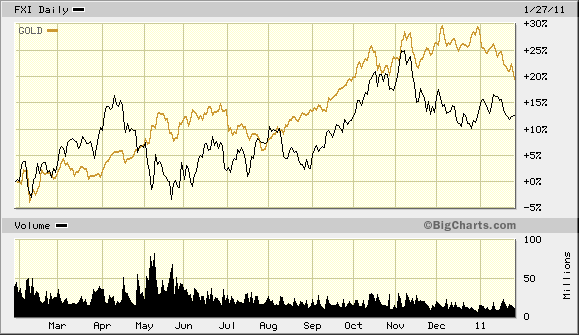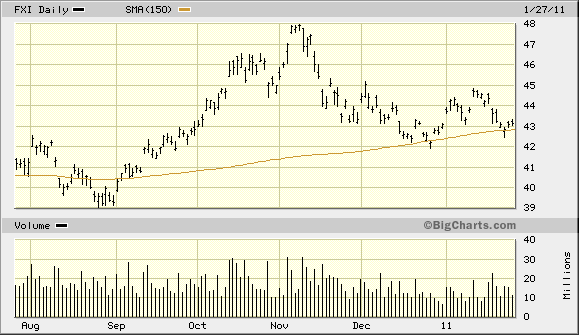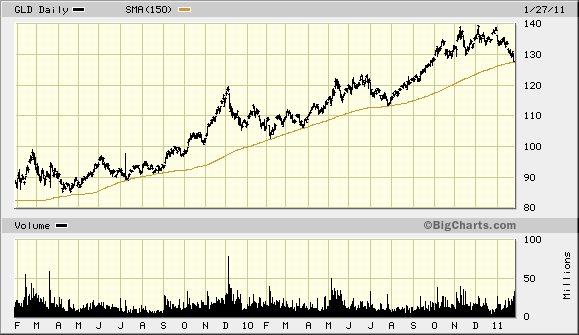Is the Fed Taking the Economic Recovery Too Far, Too Fast?
Economics / Economic Recovery Jan 28, 2011 - 05:26 AM GMTBy: Clif_Droke

 The latest round of economic numbers continues to impress Wall Street and is keeping hopes of a continued economic recovery alive. Many observers question, however, if perhaps the Fed is taking the recovery too far, too fast.
The latest round of economic numbers continues to impress Wall Street and is keeping hopes of a continued economic recovery alive. Many observers question, however, if perhaps the Fed is taking the recovery too far, too fast.
On Wednesday, the Commerce Department reported that new home sales for December increased 17.5% month-over-month to an annualized rate of 329,000 units. This was above the consensus rate of 300,000 units and traders jumped into stocks on the news. The 17.5% increase comes following the 5.5% gain that occurred in November.
In previous recessions it was always industrial production and small businesses that led the economic recovery. This time it has been agricultural producers and foreign buyers that have had the biggest hand in helping the country emerge from recession. As economics writer Daniel Gross pointed out in his latest Newsweek column, “foreigners have done so much to help America in its post-crash time of need. They helped keep interest rates low by investing in U.S. government bonds and spent freely on U.S. goods and services.” Gross concluded that America’s ability to recover its financial health ultimately depends on the health of the global economy.
More than any single factor, the Federal Reserve’s “easy money” policy has been one of the major drivers behind the stock market recovery that began in March 2009 and it has also clearly benefited the economy by extension. The market’s response to the Fed’s latest policy statement on Wednesday was positive as the Fed left rates unchanged. More importantly, the Fed voiced its intention to carry on with its bond buying program, which is designed to further stimulate the economy. The Fed is concerned about the 9.4% unemployment rate and said it will continue its easing policy until the unemployment rate comes down.
There are a couple of things that could be said on this score. The recent tax cut package that took effect in January puts less pressure on the Fed to stimulate growth. Recent gains in industrial production and consumer spending are further signs that the economic recovery is still on track. Our own New Economic Index (NEI) just recent made a new recovery high and has been pointing toward economic strengthening for more than a year. But the Fed is targeting unemployment and until it sees the numbers improve it isn’t likely to stop its easy money policy.
While it’s normally beyond the scope of this commentary to discuss monetary policy, I can’t help wondering if Fed Chairman Bernanke realizes he may be embarking on a dangerous course. Bernanke is the nation’s premier scholar of the Great Depression scholar and probably knows better than anyone the value of monetary stimulus following a financial collapse. Although he arguably waited too long to begin fighting deflation during the credit inferno, he at least did an adequate job of helping to stabilize the financial system when finally he decided to take action. The last two years have given the financial market and the economy a much needed respite from the severe deflationary pressures that prevailed in 2007-2008. Now the economy has reached a point where any further stimulus could very well stoke an asset bubble, both in stocks and especially commodities.
Every Fed president until now has been unable to achieve equilibrium but each has overstayed the limits of the prevailing monetary policy, whether tight or loose. It takes an exceptional amount of self-awareness and prescience to know when, for instance, to stop a monetary easing campaign. The normal course is to continue the easing for too long, thus paving the way for the next economic crisis.
It’s s debatable proposition to be sure, but I wonder if maybe the Fed is mistaken in trying to lower the employment rate. The assumption behind the “high” level of unemployment is that it’s bad for the economy. But how much of those unemployment numbers represent older workers who were nearly retirement age and ready to exit the economy anyway? You may recall that back in the ‘90s the media constantly reminded us that the first big retirement wave of Baby Boomers would begin sometime around 2011. Well here we are in 2011, and is it really surprising that America has shown a diminished appetite for taking on debt and making major purchases at this stage of the demographic curve?
Perhaps then the Fed is making a critical mistake in trying to reverse what is, by all appearances, a natural trend. The Fed’s monetary stimulus has clearly had a spillover effect in commodity prices, most notably the petroleum and agricultural markets. Bernanke as much as acknowledged this during Wednesday’s FOMC meeting but expressed no concern that this would create “dislocations” (to use a Greenspan term) in the broader economy. It might be in everyone’s best interest if the Fed eased off the monetary accelerator just a bit until the economy can fully absorb the recent commodity price increases.
Turning our attention to the global markets, the dominant theme lately has been the lagging performance of the Chinese stock market and the correction in the gold and silver mining stocks. Earlier in this commentary I quoted Mr. Gross, who said that America’s recovery was in large part dependent on the health of the global economy. I suspect the lagging performance in China stocks, gold and gold mining stocks are interrelated and are indirectly a reflection on the overseas economy.
One of the relationships that has emerged in recent years has been the link between the direction of China’s stock market and the gold price. Typically, what’s good for China is good for gold as Chinese demand for the yellow metal is particularly voracious both on the industrial as well as on the consumer level. When the Chinese stock market weakens and begins to decline, the gold price usually follows at some point after a temporary lag. One can surmise that as Chinese equities come under strong selling pressure and liquidity becomes more of an issue, investors are eventually forced into liquidating gold. The more severe the decline in Chinese shares, the more serious the correction in the gold price tends to be.

Technically speaking, the Chinese stock market broke an important long-term trend line, namely the 30-week (150-day) moving average about a year ago. Since then China stocks have been struggling to regain traction above the 30-week MA with only temporary periods of success. For all intents and purposes China equities have been in a bear market for the past year. The China 25 Index Fund ETF (FXI) is a good proxy for the Chinese market and as you can see it’s trying to re-establish support above the 30-week moving average. A failure here would suggest serious trouble for China and would also likely have a spillover effect on the gold price. All eyes should be on China’s stock market relative to the 30-week MA.

Meanwhile the gold price fell to its 30-week moving average on Wednesday, Jan. 27. This marks the first test of this important longer-term trend line since last July. The previous two times the gold price has experienced a corrective decline in the past year, the 30-week MA held firm and ultimately stopped the decline and reversed the correction. The 30-week moving average has also stopped each and every correction in the gold ETF (GLD) in the last two years as you can see in the following chart. The last time GLD decisively violated its 30-week/150-day moving average was during the credit crisis of 2008.

Since gold and the gold ETF have experienced a prolonged bull run above the 30-week MA for the last two years an argument could be made that a more serious corrective pullback lies ahead and that this time the 30-week MA will fail to contain gold’s decline. Gold is extremely oversold technically in the short term, however, and could use a bounce. Many institutional traders and hedge fund operators are looking at the 30-week trend line and there will probably be a fierce struggle between buyers and sellers around this important moving average in the days ahead. The conflict should be decided in the next few days and provided the 30-week MA isn’t significantly violated the buyers will have some room to maneuver the gold price back in their favor for a while.
China is the wild card here. If China’s stock market can somehow gain traction and pull out of its recent malaise, a gold price recovery should follow. But if China continues to weaken, gold will again come under pressure at some point in the near future.
Gold & Gold Stock Trading Simplified
With the long-term bull market in gold and mining stocks in full swing, there exist several fantastic opportunities for capturing profits and maximizing gains in the precious metals arena. Yet a common complaint is that small-to-medium sized traders have a hard time knowing when to buy and when to take profits. It doesn’t matter when so many pundits dispense conflicting advice in the financial media. This amounts to “analysis into paralysis” and results in the typical investor being unable to “pull the trigger” on a trade when the right time comes to buy.
Not surprisingly, many traders and investors are looking for a reliable and easy-to-follow system for participating in the precious metals bull market. They want a system that allows them to enter without guesswork and one that gets them out at the appropriate time and without any undue risks. They also want a system that automatically takes profits at precise points along the way while adjusting the stop loss continuously so as to lock in gains and minimize potential losses from whipsaws.
In my latest book, “Gold & Gold Stock Trading Simplified,” I remove the mystique behind gold and gold stock trading and reveal a completely simple and reliable system that allows the small-to-mid-size trader to profit from both up and down moves in the mining stock market. It’s the same system that I use each day in the Gold & Silver Stock Report – the same system which has consistently generated profits for my subscribers and has kept them on the correct side of the gold and mining stock market for years. You won’t find a more straight forward and easy-to-follow system that actually works than the one explained in “Gold & Gold Stock Trading Simplified.”
The technical trading system revealed in “Gold & Gold Stock Trading Simplified” by itself is worth its weight in gold. Additionally, the book reveals several useful indicators that will increase your chances of scoring big profits in the mining stock sector. You’ll learn when to use reliable leading indicators for predicting when the mining stocks are about o break out. After all, nothing beats being on the right side of a market move before the move gets underway.
The methods revealed in “Gold & Gold Stock Trading Simplified” are the product of several year’s worth of writing, research and real time market trading/testing. It also contains the benefit of my 14 years worth of experience as a professional in the precious metals and PM mining share sector. The trading techniques discussed in the book have been carefully calibrated to match today’s fast moving and volatile market environment. You won’t find a more timely and useful book than this for capturing profits in today’s gold and gold stock market.
The book is now available for sale at: http://www.clifdroke.com/books/trading_simplified.html
Order today to receive your autographed copy and a FREE 1-month trial subscription to the Gold Strategies Review newsletter. Published each week, the newsletter uses the method described in this book for making profitable trades among the actively traded gold mining shares.
By Clif Droke
www.clifdroke.com
Clif Droke is the editor of the daily Gold & Silver Stock Report. Published daily since 2002, the report provides forecasts and analysis of the leading gold, silver, uranium and energy stocks from a short-term technical standpoint. He is also the author of numerous books, including 'How to Read Chart Patterns for Greater Profits.' For more information visit www.clifdroke.com
Clif Droke Archive |
© 2005-2022 http://www.MarketOracle.co.uk - The Market Oracle is a FREE Daily Financial Markets Analysis & Forecasting online publication.


